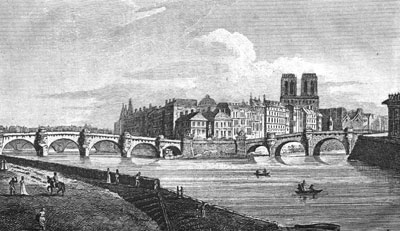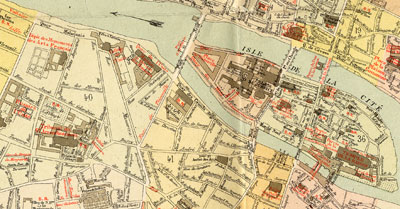|

NOTES ON ISSUE 13: GLOSSARY
PART 1 OF 2
Printable View
…Miss Pross threaded her way
along the narrow streets and crossed the river by the bridge of the
Pont-Neuf…
The Pont Neuf, which connects the Ile de la Cité (the island on
which Notre Dame, the Palais de Justice, and the Conciergerie stand)
with the banks of the Seine, was begun in 1578, but not completed until
the beginning of the 17th century. Tronchet’s Picture of Paris
(c. 1818) gives the following description of its original construction
and characteristics:
The length of the bridge is 1020
feet, and its breadth 72 feet, which is sufficient to admit of five
carriages passing abreast. It is formed of twelve arches, seven of
which are on the side of the Louvre, and five on the side of the Quai
des Augustines, extending over the two channels of the river, which is
wider in this place, from their junction. In 1773, the parapets were
repaired, and the footway lowered and narrowed. Soufflot, the architect
of the church of St. Genevieve [now known as the Pantheon], availed
himself of the opportunity to build, on the twenty half moons which
stand immediately above each pile, as many rotundas, in stone, to serve
as shops. On the outside, above the arches, is a double cornice, which
attracts the eye of the connoisseur in architecture, notwithstanding
its mouldering state, on account of the fleurons in the antique style, and
the heads of sylvans, dryads, and satyrs, which serve as supports to
it, at the distance of two feet from each other. As the mole that forms
a projection on this bridge, between the fifth and seventh arch, stands
facing the Place Dauphine, which was built by Henr[i] IV, it was chosen
for erecting to him a statue, which was the first public monument of
the kind that had been raised in honor of French kings. (173-4)
Unfortunately, during the Revolution,
French kings of every description became unpopular, and in 1792 the
statue of Henri IV was melted down and “converted into cannon”
(Baedeker 219). Thus, the statue would not have been standing when Miss
Pross crosses the bridge in late 1793 or early 1794. It was replaced,
however, in 1818, such that the bridge recovered – at the beginning of
the 19th
century – something of its pre-revolutionary appearance.
Further restored in the early 1850s, the Pont Neuf of Dickens’ time
would not have been quite the same bridge crossed by Miss Pross – “The
slopes were very much lessened, the arches were partially
reconstructed, and the footpaths and parapets were altogether renewed” (Dickens’s Dictionary of Paris
40-1).
From the 17th century onward, the Pont Neuf was an especially
lively part of Paris – most 19th-century guidebooks make
reference to it as a kind of popular gathering place. The Picture
of Paris (c.1818) notes that
The
Pont Neuf is to the town what the heart is to the body; that is, the
centre of life and circulation. The passing and repassing of the
inhabitants, as well as of strangers, so incredibly throngs the bridge,
that to find any one whose place of abode you cannot come at, you have
no more to do than walk there for a short space of time every morning.
The government police practice this, and, at the expiration of some
days, if they meet not the man they look after, they pronounce him not
to be in Paris. (173-4)
Further, Baedeker’s Paris and Its Environs (1878)
remarks that the Pont Neuf was a “favourite rendezvous of jugglers,
showmen, loungers, and thieves. Any popular witticism in verse
was long known as ‘un Pont Neuf’” (220). And Dickens’s Dictionary of Paris
(1882) notes that
During
the 17th and the 18th centuries the Pont Neuf was the scene of much
gaiety and merriment. It was there that mountebanks loved best to
exercise their calling; there charlatan surgeon-dentists established
themselves; and there quack doctors of all sorts found patients
innocent enough to entrust themselves to their care. “Le Pont Neuf
c’est Paris” ["The Pont Neuf is Paris"] was long a proverb among the
populace…. (40-1)
The illustration of the Pont Neuf
below, taken from Tronchet’s Picture of Paris (c.1818), shows
the bridge before its renovation in the 1850s, and thus (with the
exception of the equestrian statue of Henri IV) much as it would have
appeared when Miss Pross crosses it in the 1790s.

It is amusing to note, in connection with the re-erected statue of
Henri IV, that
it was “procured by melting down a couple of statues of Napoleon and
one of General Desaix” (Handbook to Paris 162). The statue
still stands today; and the Pont Neuf (“New Bridge” in English) is now
the oldest bridge in Paris (Baillie and Salmon 71).

Click
on map for larger view
Miss Pross’ route, from the Saint Germain quarter on the south side of
the Seine, over the Pont Neuf at the west end of the Ile de la
Cité, is visible on this portion of the Plan de la Ville de
Paris, Période Révolutionnaire, 1790-1794.
(The Saint Germain quarter, named for the Abbey of
Saint-Germain-des-Prés, is at the lower left, and can be roughly
located
according to the position of the Abbey. The Abbey is the
large dark building above the Rue Marguerite and under the dotted
square labeled “Jardin de l’Abbaye.” The Pont Neuf is the
westernmost bridge leading onto the Ile de la Cité.)
…the barges were stationed in which the smiths
worked, making guns for the Army of the Republic.
Dickens takes this detail of the barges from Carlyle’s description, in The
French Revolution, of the French resolution to repulse foreign
invasion:
Accordingly,
alongside of these bonfires of Church-balustrades, and sounds of
fusillading and noyading, there rise quite another sort of fires and
sounds: Smithy-fires and Proof-volleys for the manufacture of arms.
Cut off from Sweden and the world, the Republic must learn to make
steel for itself; and, by aid of Chemists, she has learnt it. Towns
that knew only iron, now know steel…. Two-hundred and fifty-eight
Forges stand in the open spaces of Paris itself; a hundred and forty of
them in the Esplanade of the Invalides, fifty-four in the Luxembourg
Garden: so many Forges stand; grim Smiths beating and forging at lock
and barrel there. The Clockmakers have come, requisitioned, to do the
touch-holes, the hard-solder and file-work. Five great Barges swing at
anchor on the Seine Stream, loud with boring; the great press-drills
grating harsh thunder to the general ear and heart. (702-3)
After peeping into several
wine-shops, she stopped at the sign of The Good Republican Brutus of
Antiquity…
Although it is possible that the “Good Republican Brutus
of Antiquity” is Marcus Junius Brutus, who assassinated
Julius Caesar, it is more probable that the Brutus commemorated
in the name of the Parisian wineshop is Lucius Junius Brutus.
This latter Brutus rebelled against King Tarquin (the last Roman
king), and helped to establish the Roman Republic. As a Republican
figure – revolutionary and anti-monarchical – he
became a kind of classical model for the French revolutionaries
(Maxwell 474). He was commemorated by Jacques-Louis David in
“The Lictors Returning to Brutus the Bodies of His Sons”
(1789, oil on canvas). (David was a prominent figure in
the French Revolution, and a well-known painter; Carlyle, for
instance, continually invokes him simply as “Painter David”
in The French Revolution.) David’s
painting of “The Lictors Returning to Brutus the Bodies
of His Sons” depicts Brutus’ condemnation of his
two sons, who were executed for conspiring to restore the monarchy.
The painting can be viewed, together with a number of David’s
other works, at www.abcgallery.com (search for David under D).
As the name of Dickens’ wineshop implies, “classical” figures and
motifs
were popular with the French Republic (which, in its own view, modeled
itself after the Roman one), and a modified classical costume was often
adopted by good Republicans. As Fairholt’s History of Costume in
England (1860) notes,
The
modern-antique style of dress, an attempt to engraft a classical taste
in costume, … appeared [in the late 18th century]; [this was] the
result of the
French Revolution, when every brawler believed himself a Cato or a
Brutus…. The rough-cropped head then fashionable was termed “a Brutus”
by the French, after the great hero of antiquity, whom they especially
reverenced…. [A]nd an air of ghastly burlesque was cast over scenes of
blood at which humanity sickens, by a misplaced assumption of classic
patriotism. This modification of the antique habit had good effect,
[however,] inasmuch as it encouraged simplicity; and the female costume
up to 1800 was, in truth, unpretending and lady-like. (Fairholt 330)
Carlyle likewise, in The French Revolution, records the
popularity of
the “modern Brutus’ head” (266) in France, and describes how, when the
Terror ended (with Robespierre’s execution), the revolutionary garb of
Parisians gave way to a classical costume indicative of a shift in
political feeling:
All
Sansculottic things are passing away; all things are becoming Culottic.
Do but look at the cut of clothes; that light visible Result,
significant of a thousand things which are not so visible. In winter
1793, men went in red night-cap; Municipals themselves in sabots, the very Citoyennes had to
petition against such headgear. But now in this winter 1794, where is
the red night-cap?… Your moneyed Citoyen ponders in what elegantest
style he shall dress himself; whether he shall not even dress himself
as the Free Peoples of Antiquity. The more adventurous Citoyenne has
already done it. Behold her, that beautiful adventurous Citoyenne: in
costume of the Ancient Greeks, such Greek as Painter David could teach;
her sweeping tresses snooded by glittering antique fillet; bright-dyed
tunic of the Greek women; her little feet naked, as in Antique Statues,
with mere sandals, and winding-strings of riband, – defying the frost!
(749)
At the time of Miss Pross’ visit to the
“Good Republican Brutus of Antiquity,” the Terror still
reigned, and the red woolen “cap of Liberty” would still have been in
vogue.
|

